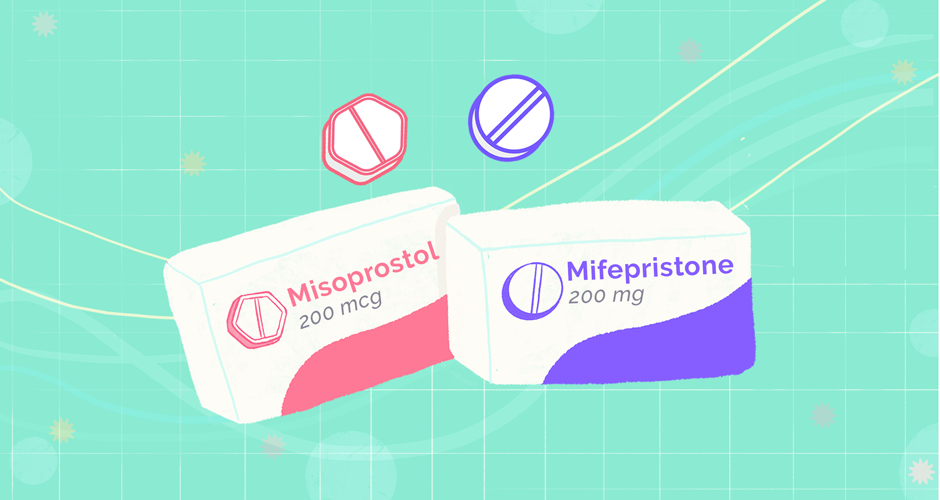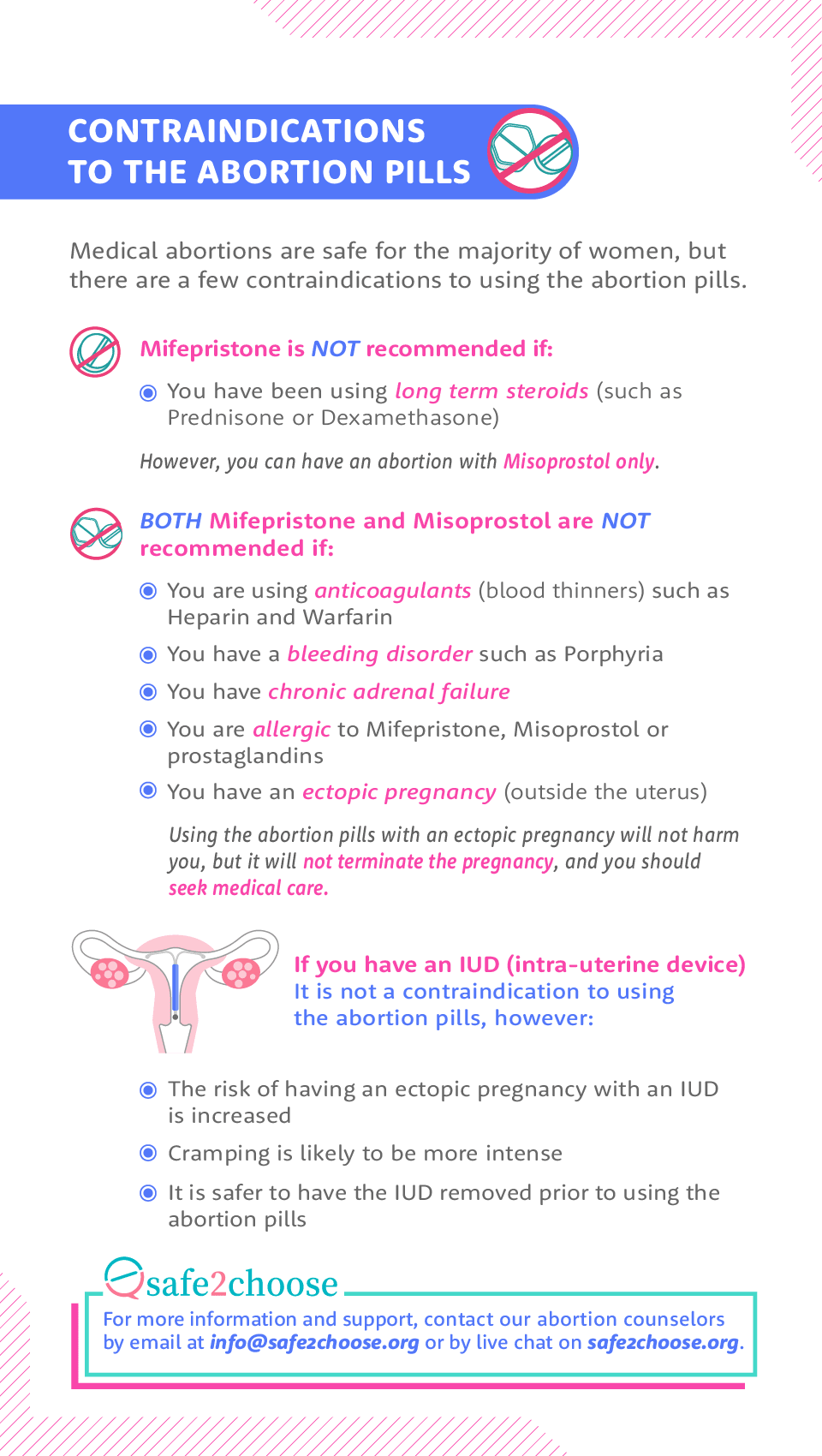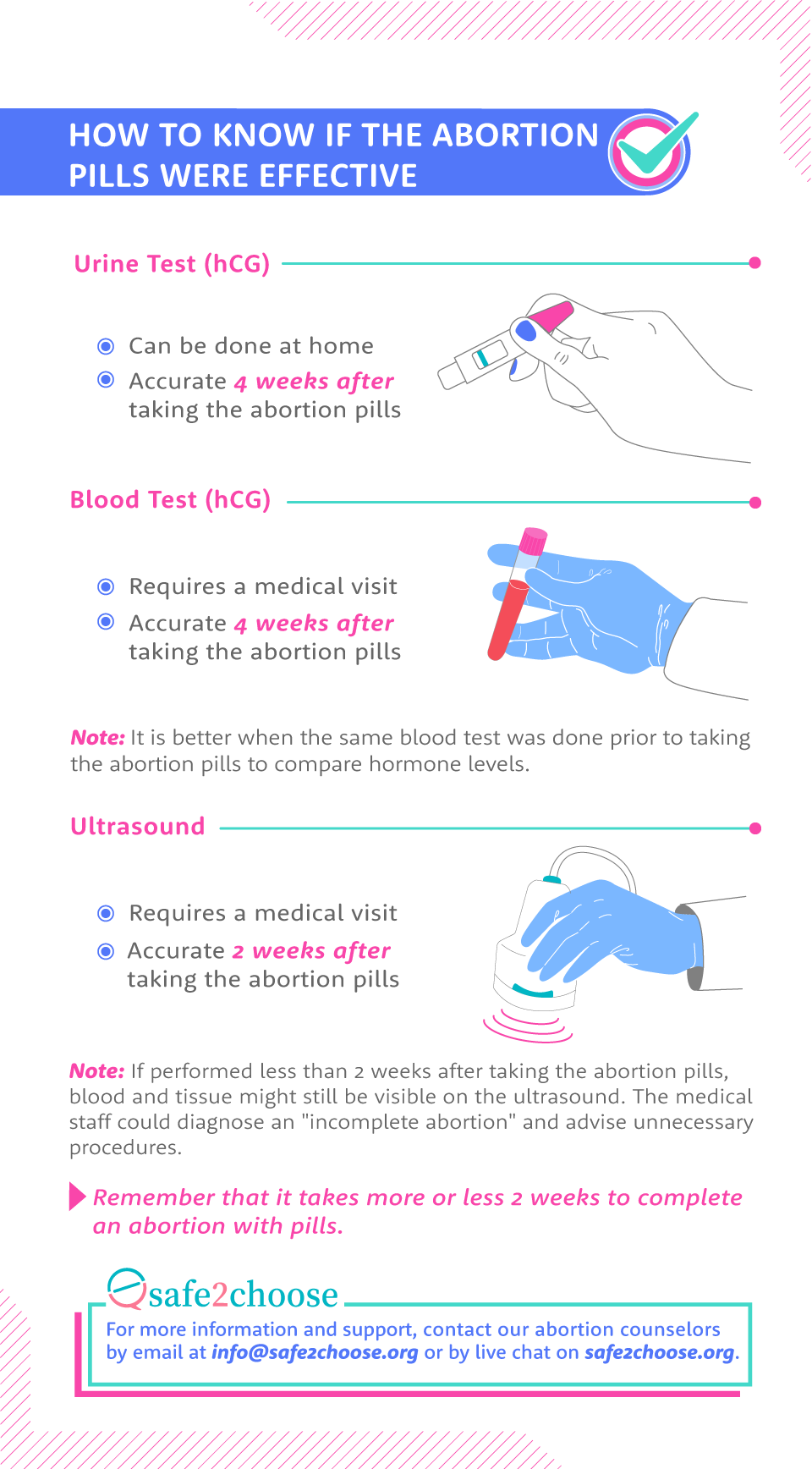
A medical abortion [1] is commonly known as an abortion with pills. Some people also refer to this method as self-induced abortion, self-managed abortion [2] or do-it-yourself (DIY) abortion.
If you use abortion pills, you will experience bleeding and cramping. The symptoms are very similar to your menstrual period or as if you were having a miscarriage (natural abortion).
The abortion pills generally refer to either using Mifepristone and Misoprostol in succession or using only Misoprostol.
Mifepristone
– Mifepristone is a medication that blocks the flow of progesterone, which is a hormone that supports the pregnancy. Without progesterone the pregnancy cannot grow. Mifepristone is only one half of what is commonly known as the abortion pill or medical abortion, it will not result in an abortion by itself. [3]
– Mifepristone also softens the cervix (lower part of the uterus) which will intensify Misoprostol’s effect. [4]
– Mifepristone alone is not enough to cause an abortion, Misoprostol is also needed. [5]
– Mifepristone is primarily used for abortion or miscarriage, so depending on laws and restrictions in each country, it can sometimes be difficult to find. [6]
Misoprostol
– Misoprostol is a medication which causes the uterus to move (or contract), and this helps to expel the pregnancy with cramping and bleeding.
– A medical abortion can be performed using Misoprostol without Mifepristone, but it is more effective to use both medications together.
– Misoprostol has other medical uses aside from abortion (induce labor, postpartum hemorrhage, ulcer, etc), so it is typically more widely available. [7]
Mifepristone and Misoprostol are listed as essential medications according to the World Health Organization and they are intended for safe abortions. [8]
To know how to have a safe and effective abortion using Misoprostol and Mifepristone click here. If you are using Misoprostol only click here.
Safety of abortion pills and Contraindications:
Medical abortions are safe for the majority of women. There are only a few medical conditions that are contraindications for using the abortion pills. [9]
Mifepristone is NOT recommended if
– You have been using long term steroids (such as Prednisone or Dexamethasone). However, you can have an abortion with Misoprostol only.
BOTH Mifepristone and Misoprostol are NOT recommended if [10]:
– You are using anticoagulants (blood thinners) such as Heparin and Warfarin,
– You have a bleeding disorder such as Porphyria,
– You have chronic adrenal failure,
– You are allergic to Mifepristone, Misoprostol or prostaglandins. The only way to know if you are allergic is if you have used these before and had an allergic reaction. It is impossible to know before using the pills if you will be allergic or not.
– You have an ectopic pregnancy (outside the uterus). In this case, the abortion pills will not harm you, but they will not terminate the pregnancy. If you know you have an ectopic pregnancy, you should seek medical care.
If you have an IUD (intra-uterine device) it is not a contraindication to using the abortion pills, but it does require some precaution. The risk of having an ectopic pregnancy (pregnancy not inside the uterus) is increased when you have an IUD in place. Cramping is also likely to be more intense when using the pills with an IUD in place. Whenever possible, the safest recommendation is to have the IUD removed prior to using the abortion pills. [11]
If you are not sure if the abortion pills are safe for you, contact us! We can help you determine if this method is for you.
Remember safe2choose is only trained to support women who will use abortion pills in the first 13 weeks of pregnancy. If your pregnancy is more advanced, we will do our best to refer you to a better prepared organization that will support you. [12]

What to expect during an abortion with pills
After using the abortion pills you will have symptoms similar to a menstrual period or a miscarriage. If you are using Mifepristone, this medication does not usually cause any symptoms. Most of the symptoms will occur only after using the Misoprostol.
The intended symptoms include: cramping, bleeding, and possibly passage of blood clots. Usually the most intense bleeding and cramping will occur within the first 48 hours after using Misoprostol, but you may experience bleeding on and off for several days or weeks. [13]
Misoprostol can cause temporary side effects such as fever, chills, diarrhea, nausea, vomiting, and headaches. If you do not experience any of these it is perfectly normal. If you do, these will disappear in the next 48 hours or less. [13]
Contact us to know how to manage side effects.
How to know if the abortion pills worked
If you used the medications according to the recommended instructions, and you had a bleeding as abundant as your menstrual period (or more) for several hours, it is very likely the medical abortion was successful. Your pregnancy symptoms (breast tenderness, nausea, fatigue), should gradually improve and then disappear around 5 days after using abortion pills. This is another good indication that the pills were successful. [11]
While it is not necessary, if you desire additional confirmation you may choose to do one of the following test:
– Urine test (urine hcg): This is the simplest test that can be done for confirmation, as it can be done in the privacy of your own home. It is recommended to wait at least approximately 4 weeks after using the abortion pills. If the process was successful, the test should be negative after approximately 4 weeks.
– Blood test (quantitative hcg): This test requires a medical visit, and is most useful when the same blood test was also done prior to using the abortion pills for comparison of the hormone levels. This test is not routinely performed, and thus if you desire confirmation the urine test as described above is more often recommended. If you do choose to do this test, the pregnancy hormone should be absent approximately 4 weeks after medication use if the process was successful.
– Ultrasound: This requires a medical visit, and can be used to detect an ongoing pregnancy. Keep in mind that if the abortion pills worked, there may still be some blood and tissue visible on ultrasound for at least 2 weeks. Even if the pregnancy is gone, sometimes the ultrasound is performed too early and women are diagnosed with an “incomplete abortion” which could lead to unnecessary surgical procedures. If you choose to have an ultrasound, it is recommended to wait at least 2 weeks, unless you have symptoms of complications and need an ultrasound sooner.
If 48 hours have passed after you used the last dose of Misoprostol and you have not bled or your bleeding is much less amount than your period, it is likely that the abortion was not successful. [14]
In most cases, it is possible to try again with abortion pills. Contact us if this is your case so we can support you.
Medical care after the abortion pills
If your symptoms are as expected and you do not have any warning signs, you do not need to get medical care. It is not necessary to get a pregnancy test or an ultrasound afterwards, nor having any surgical intervention such as a D&C.

Fertility and menses after an abortion
After an abortion (surgical or medical) your cycle will restart, as if you have had your menstrual period. You will ovulate again approximately 10 days afterwards. This means that you can get pregnant again if you have unprotected sex. [11]
If you are not ready to become pregnant again, you should consider methods of pregnancy prevention. You can find more information at FindMyMethod.org
Your next period can come back in approximately 4 to 6 weeks after using abortion pills. [15]
by the safe2choose team and supporting experts at carafem, based on the 2020 recommendations by The National Abortion Fund (NAF).
The National Abortion Federation is the professional association of abortion providers North America.
carafem provides convenient and professional abortion care and family planning so people can control the number and spacing of their children.
[2] Reproductive Health Matters. Self-management of medical abortion: a qualitative evidence synthesis. Retrieved from: https://www.tandfonline.com/doi/pdf/10.1016/j.rhm.2016.06.008?needAccess=true
[3] Children by Choice. Medication abortion. Retrieved from: https://www.childrenbychoice.org.au/foryou/abortion/medicationabortion
[4] S. Hopkins MD, M. Fleseriu MD. Chapter 7 – Medical Treatment of Cushing’s Disease. Retrieved from: https://www.sciencedirect.com/science/article/pii/B9780128043400000073
[5] Thoai D Ngo, Min Hae Park, Haleema Shakur & Caroline Free. Comparative effectiveness, safety and acceptability of medical abortion at home and in a clinic: a systematic review. Retrieved from: https://www.who.int/bulletin/volumes/89/5/10-084046/en/
[6] Brooke Ronald Johnson, Vinod Mishra, Antonella Francheska Lavelanet, Rajat Khosla & Bela Ganatra. A global database of abortion laws, policies, health standards and guidelinesArticle has an altmetric score of 221. Retrieved from: https://www.who.int/bulletin/volumes/95/7/17-197442/en/
[7] Webmd. Misoprostol. Retrieved from: https://www.webmd.com/drugs/2/drug-6111/misoprostol-oral/details
[8] WHO. Access to essential medicines as part of the right to health. Retrieved from: https://www.who.int/medicines/areas/human_rights/en/
[9] Ipas. Medical abortion contraindications and precautions. Retrieved from: https://www.ipas.org/clinical-updates/general/ma-precautions
[10 WHO. Essential Medicines List Application Mifepristone–Misoprostol for Medical Abortion. Retrieved from: https://www.who.int/selection_medicines/committees/expert/22/applications/s22.1_mifepristone-misoprostol.pdf?ua=1
[11] Ipas. (2019). Clinical Updates in Reproductive Health. L. Castleman & N. Kapp (Eds.). Chapel Hill, NC: Ipas. Retrieved from: https://ipas.azureedge.net/files/CURHE19-april-ClinicalUpdatesInReproductiveHealth.pdf
[12] National Abortion Federation. 2020 Clinical Policy Guidelines for Abortion Care. Retrieved from: https://5aa1b2xfmfh2e2mk03kk8rsx-wpengine.netdna-ssl.com/wp-content/uploads/2020_cpgs_final.pdf
[13] Planned Parenthood. How does the abortion pill work? Retrieved from: https://www.plannedparenthood.org/learn/abortion/the-abortion-pill/how-does-the-abortion-pill-work
[14] Gynuity. Abortion with self-administered misoprostol. Retrieved from: https://gynuity.org/assets/resources/polbrf_misoprostol_selfguide_en.pdf
[15] BPAS. Caring for yourself after your abortion. Retrieved from: https://www.bpas.org/abortion-care/abortion-aftercare